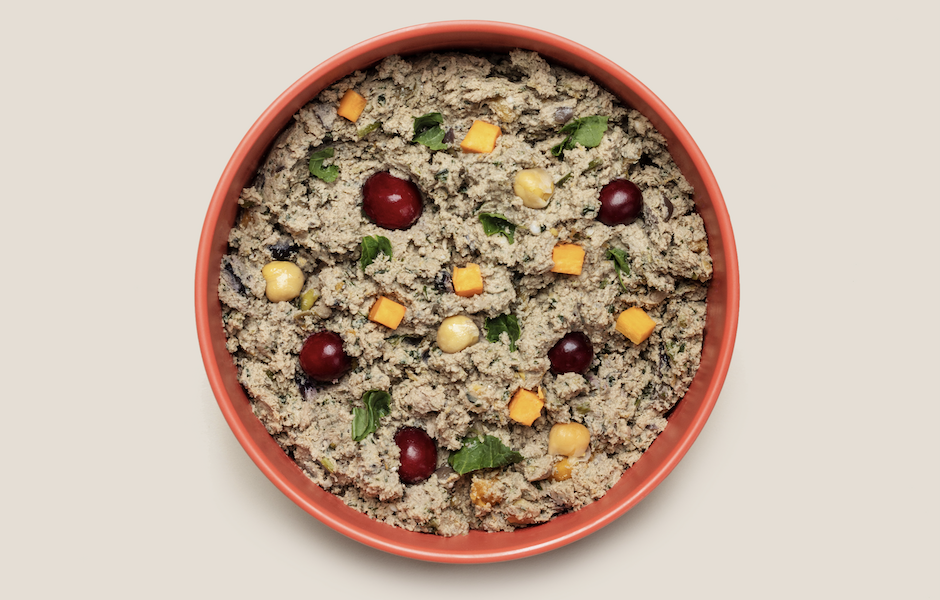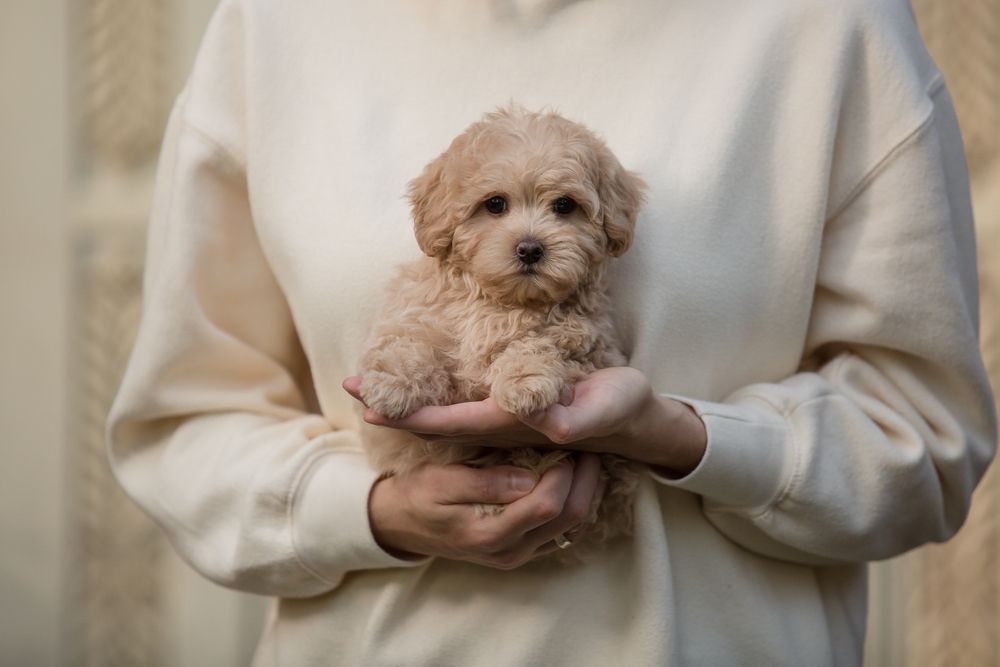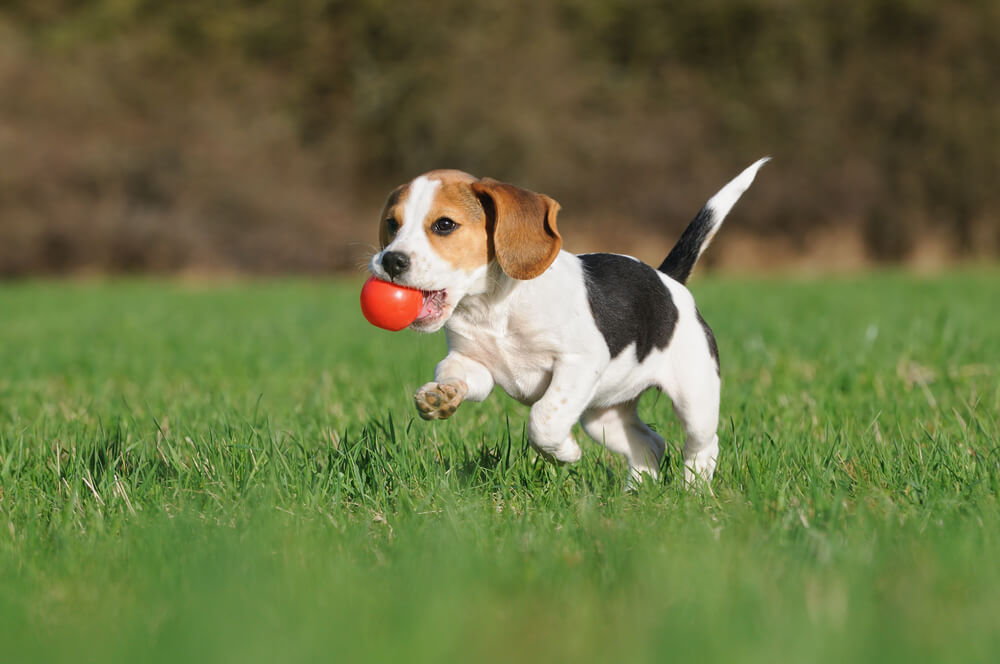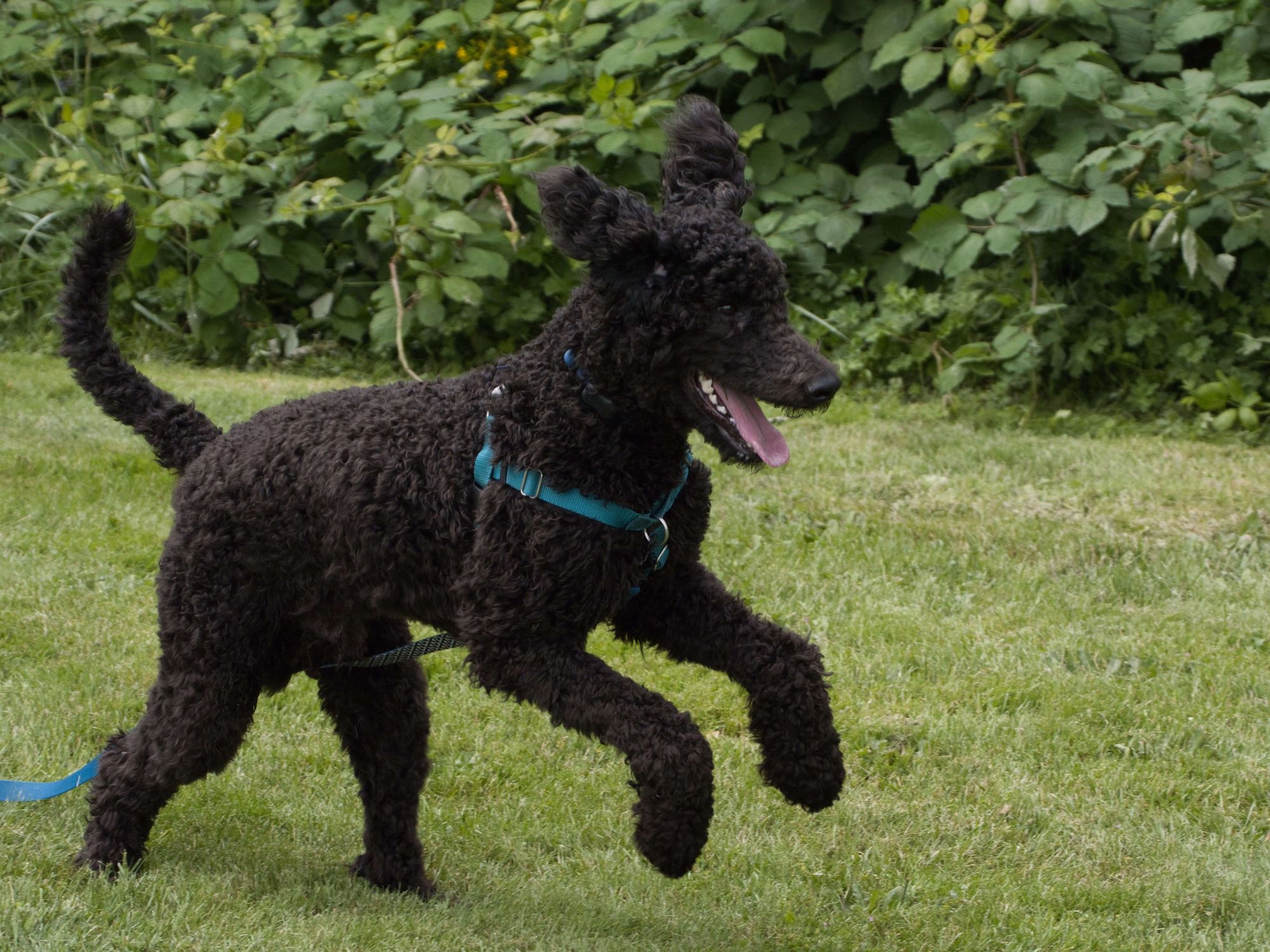Hey Ollie blog readers! We’re offering you an exclusive 60% OFF your starter box! Try now!
Maltipoos are a charming hybrid breed that, as their name suggests, combines the Maltese with a miniature or toy poodle. If you’re wondering how this adorable pint-sized pup would fit into your family or lifestyle, check out our Maltipoo Dog Breed guide to review the pros and cons of Maltipoos.
About the Maltipoo Dog Breed
As a designer dog, the Maltipoo breed does not have a lengthy origin story. However, while this mixed breed is relatively new, their popularity is skyrocketing.
The best way to become familiar with the Maltipoo breed is to learn about the parent breeds. You need to consider the common Maltipoo health issues this mixed breed has inherited from the poodle and the Maltese, including digestive issues, allergies, epilepsy, and luxating patellas (i.e., slipping kneecaps). However, mixed-breed dogs also experience hybrid vigor, a health advantage that makes them less likely to suffer from their purebred ancestors’ health issues.
Maltipoos’ coats are beautiful and colorful, and come in various textures, characteristics attributable to their unique parentage. Similar to poodles, Maltipoos are low shedding, which makes them an ideal pet for allergy sufferers.
Finally, a Maltipoo’s adult size depends on their parentage. The breed varies greatly in height (4 to 14 inches at the shoulder) and weight (3 to 20 pounds), depending on whether their poodle parent was a toy or miniature. And like most small breeds, what the Maltipoo lacks in size they make up for in longevity, with an average life span of 10 to 15 years.
Maltipoo Dog Breed Guide
| Trait: | Details: |
| Size: | Small (5 – 20 pounds) |
| Coat Type: | Curly or wavy fur, low-shedding |
| Life Expectancy: | 12-16 years |
| Energy Level: | Moderate to High |
| Good With Kids? | Yes |
| Good For Apartments? | Yes |
| Hypoallergenic? | Considered Low-Allergen |
| Barking Level: | Moderate |
| Trainability: | High |

Pros and Cons of Maltipoos – Is A Maltipoo The Right Dog For You?
Before you decide if a Maltipoo is the perfect pup for your family, you should learn about some of the most commonly reported pros and cons of this dog breed:
Pros of Maltipoos
1. Good for Apartments
The Maltipoo is a small breed that is ideal for apartment living. Many apartment and condo complexes restrict pets who weigh more than 25 or 50 pounds, making the Maltipoo a welcome companion almost anywhere. In addition, the Maltipoo’s small stature makes providing adequate exercise, play, and physical activity easy, even when they are limited to indoor spaces because of weather, location, or lifestyle.
2. Low Shedding
Although no dog is completely hypoallergenic, adults and children who are allergic to pet dander appreciate the Maltipoo’s low shedding coat. Similar to other poodle mixes, Maltipoo owners who are generally allergic to dogs can comfortably share their life—and home—with this lovable designer breed.
10 “Hypoallergenic” Small Breeds to Consider
3. Friendly
Maltipoos are friendly pups and can be great companion dogs for children and seniors alike. They often also thrive as therapy dogs, happily providing comfort and cheer to anyone in need. Although Maltipoos are generally good-natured and gentle, an adult should always supervise all interactions between dogs and children. According to the American Kennel Club, Poodles are one of the top five most intelligent breeds—traits Maltipoos often inherit.
4. Breed Availability
Unlike some purebreds, Maltipoos are generally available for purchase or adoption. Their consistent popularity is likely a testament to the breed’s benefits. The best resources for finding your future pup include:
- Breed-specific rescue groups — If no Maltipoo-specific organizations are in your area, contact local or regional Maltese, poodle, or small-breed dog rescues. These groups usually take in Maltipoos.
- Shelters and humane societies — Although many dog lovers consider the Maltipoo to be a perfect fit, many of this mixed breed’s puppy and adult dogs are still routinely surrendered to shelters. Ask local animal shelters to notify you if a Maltipoo becomes available for adoption.
- Reputable breeders — Responsible breeders are able to provide detailed information about their litters, including each parent’s health testing results, and veterinarian and previous puppy adopter references. In addition, Maltipoo breeders should encourage you to visit their home or kennel and meet the dogs.
Cons of Maltipoos
1. Sensitive Temperament
Maltipoos are generally highly sensitive to their environment. Loud or sudden noises, negative social interactions (e.g., scolding or shouting), and chaotic or unpredictable households can easily trouble these dogs. The breed’s perceptive nature can make them appear shy, anxious, or scared, when they’re actually suffering from stress. If you frequently travel, relocate, or live in a busy, noisy, or hectic home, the Maltipoo may not be the right fit for your family. As Dr. Lisa Radosta, a board-certified veterinary behaviorist, notes, Small breeds like the Maltipoo can be prone to anxiety if left alone too long—but with the right routine, they thrive in busy homes.
2. Prone to Separation Anxiety
While separation anxiety may be true of many puppies adopted during the pandemic, the Maltipoo is particularly prone to separation anxiety. Fortunately, through consistent positive training, you can help prevent your dog from developing this condition. By teaching your puppy from a young age that their crate is a safe space and that you’ll always come back—maybe with a tasty treat—you help your dog build confidence and learn. Always remember to be consistent and kind, and to enlist a professional trainer’s help if necessary.
The Ultimate Guide to De-Stressing Your Dog
3. Coats Require Some Maintenance
The Maltipoo’s coat needs regular brushing and trimming. If you don’t want to enlist a pro for a costly grooming session every few months, you can learn to groom your dog at home. Be careful not to cut your pup or trim their hair too short, especially during the winter.
4. Puppies Can Be Expensive
Although the American Kennel Club (AKC) does not recognize the breed as being purebred, puppies can still cost upward of $4,000, which is driven by consumer demand. As an increasing number of dog lovers are discovering Maltipoos’ appeal, some unscrupulous breeders are cashing in, and you need to research breeders thoroughly to ensure you aren’t purchasing your puppy from a puppy mill. In addition to supporting unethical breeding practices—and potentially substandard living conditions—puppy mills are likely to sell sick or unhealthy dogs.
5. Prone to Barking
The Maltipoo is known as a vocal breed. Whether they are bored, excited, or responding to a change in their environment, the Maltipoo will bark to let you know how they’re feeling. Unfortunately, this self-reinforcing behavior can be problematic for owners, especially apartment dwellers. Early training and socialization are essential to ensure nuisance barking doesn’t become a habit.
Common Maltipoo Health Issues
Like all dogs, Maltipoos can run into a few health hiccups. Because they’re a mix of the Maltese and Poodle—two breeds with their own health quirks—some of these issues may be inherited. That’s why it’s helpful to know what to look out for so you can keep your pup feeling their best.
1. Dental Disease
Small breeds like the Maltipoo are prone to dental problems. Their teeth can crowd together, making it easier for plaque and tartar to build up.
Tip: Brush their teeth daily and ask your vet about professional cleanings. Adding dental chews can also help reduce buildup.
2. Luxating Patella
This is a common condition in toy and small dogs where the kneecap slips out of place. It can cause limping or skipping when they walk or run.
“Luxating patella is often hereditary in small breeds,” says the American College of Veterinary Surgeons. “Mild cases may not need treatment, but severe ones might require surgery.”
3. Tracheal Collapse
Maltipoos may develop a soft or collapsing trachea, which makes breathing harder—especially when excited or pulling on a collar.
Switch to a harness instead of a neck collar to avoid pressure on the windpipe.
4. Progressive Retinal Atrophy (PRA)
This inherited eye disease can lead to vision loss over time. It’s more common in Poodles and can show up in Maltipoo mixes.
Genetic testing in breeding dogs can reduce the risk, but routine vet eye exams help catch early signs.
5. Ear Infections
With their floppy ears and hair inside the ear canal, Maltipoos are at a higher risk for moisture buildup, which can lead to infections.
Clean ears weekly with a vet-approved cleaner, especially after baths or swimming.
6. Allergies & Skin Sensitivities
Maltipoos can be sensitive to certain foods, pollens, or grooming products. Signs include itching, redness, and licking their paws.
Feeding a limited-ingredient, fresh diet, like Ollie, can help reduce food-related reactions. Ask your vet about allergy testing if symptoms persist.
Maltipoo Grooming Guide
Maltipoos are known for their adorable teddy bear looks—and that soft, wavy coat doesn’t happen by accident. Their grooming needs are a bit more involved than short-haired breeds, but once you’ve got a routine, it becomes second nature. Here’s how to keep your Maltipoo looking (and smelling) their best.
What Kind of Coat Do Maltipoos Have?
Maltipoos are a cross between a Maltese and a Poodle, so their coat can range from soft and silky to curly and dense. Most Maltipoos have a low-shedding, hypoallergenic coat that keeps dander down—but that also means regular upkeep.
Maltipoo Grooming Checklist
Here’s a simple routine to keep your pup’s coat, skin, and paws in top shape.
Brushing (3–5 times per week)
- Use a slicker brush or a pin brush to prevent tangles.
- Work gently through knots to avoid hurting their skin.
- Pay extra attention behind the ears, under the legs, and around the collar area—mats love those spots.
Haircuts (Every 4–6 weeks)
- Regular trims help manage length and prevent mats.
- Most owners go with the “teddy bear cut”—short on the body, fluffy on the face.
- You can DIY it with clippers, but many people prefer a professional groomer.
Bathing (Every 2–4 weeks)
- Use a gentle, dog-safe shampoo made for sensitive skin.
- Don’t over-bathe—too much can dry out their coat.
- Always dry thoroughly, especially between toes and under their legs.
Ear Cleaning (1–2 times per week)
- Use a vet-approved cleaner and a cotton ball.
- Gently wipe the outer ear—never go deep into the canal.
- Look for redness, odor, or excess wax, which could mean an infection.
Nail Trimming (Every 2–3 weeks)
- Short nails are safer for joints and more comfortable.
- If you hear clicking on the floor, it’s time for a trim.
- Use a nail grinder or clipper designed for small dogs.
Eye Stain Cleaning (As needed)
- Maltipoos often get reddish tear stains under their eyes.
- Gently wipe with a damp cloth or use dog-specific tear stain wipes.
Paw Care
- Check paws regularly for debris or irritation.
- Use paw balm if the pads are dry or cracked—especially in winter or hot summers.
Pro Tip:
Maltipoos with curlier coats need more frequent brushing than those with a looser wave. If you skip a few days, mats can sneak up fast and may need to be shaved out.
Tips for Preparing Your Home for a Maltipoo Puppy
If you’ve decided a Maltipoo is the breed for you, get ready for your puppy’s arrival so they feel secure the minute they walk through your door. To ensure your home and daily routine are ready to accommodate a new puppy, follow these tips:
- Puppy-proof your home — To puppy-proof your home effectively, you need to consider each room from your puppy’s eye-level perspective and remove potential dangers such as electrical cords, breakable decor, choking hazards, and household toxins. Ensure harmful items are out of reach or kept in an inaccessible room.
- Gather supplies — Puppies need a lot of care items including a nutritious diet, food and water bowls, crate, bed, appropriate toys, treats, and a leash and collar. Other items may include grooming tools, puppy gates, and cleaning supplies for accidents.
- Set up your puppy’s den and play area — Establish a confined area in which your puppy can safely play, rest, and learn independence, so they become less likely to suffer from separation anxiety. This area should be centrally located (e.g., the kitchen or living room), so you can monitor your puppy’s activities at all times.
- Find a groomer, trainer, and veterinarian — Contact area pet professionals and register your puppy for necessary services and classes. This proactive step ensures your puppy will have a great start toward a long, healthy, and happy life.
Is a Maltipoo a Good First Dog?
The Maltipoo can be a great first pup for a new dog owner. They are well-mannered, friendly, and easy to train. As with any breed, raising a well-adjusted, happy, and healthy Maltipoo puppy takes time and effort. From teaching your puppy to be comfortable in a crate and go to the bathroom outside, to managing their puppy energy and surviving the teething stage, a new Maltipoo parent has a lot to do, learn, and experience. However, the work comes with great rewards, and the training and care you provide your new puppy will help strengthen your pet-owner bond and ensure your cute puppy grows up to be a well-mannered and delightful companion.
Maltipoos are generally healthy pups, but they need good nutrition—and lots of love—to truly thrive. At Ollie, we know a thing or two about feeding Maltipoos since this breed is one of the 10 most popular among our customers. Our recipes are created by a veterinary nutritionist with these pups’ health and taste buds in mind. Our Ollie recipes are made with carefully selected human-grade proteins and superfoods, such as blueberries, kale, and spinach. Maltipoo parents love how much their beloved pups enjoy eating Ollie.


Find Out Which Recipe Plan is Right for Your Dog’s Needs
Get 50% of your first box of Ollie’s fresh
delivered meals today!
Maltipoo FAQs
Are Maltipoos good for first-time dog owners?
Yes! Maltipoos are friendly, easy to train, and people-oriented, which makes them great for beginners. Just be ready for regular grooming and lots of attention—they don’t love being left alone for long.
Do Maltipoos bark a lot?
They can. Maltipoos tend to be alert and may bark at new sounds or strangers. Early socialization and consistent training help reduce unnecessary barking.
Are Maltipoos hypoallergenic?
No dog is completely hypoallergenic, but Maltipoos are considered a low-allergen breed because they shed very little. Their Poodle parent gives them a curly or wavy coat that traps dander, which can help reduce allergy symptoms in some people.
How big do Maltipoos get?
Most Maltipoos weigh between 5 to 20 pounds and stand about 8 to 14 inches tall at the shoulder. Size can vary depending on whether the Poodle parent was a toy or miniature variety.
How long do Maltipoos live?
The average lifespan is 12 to 16 years, with proper care, a balanced diet, and regular vet visits. They tend to live longer than many larger breeds.
Do Maltipoos need a lot of grooming?
Yes. Their low-shedding coat requires brushing several times a week, monthly trims, and regular ear cleaning and nail care. Without routine grooming, their hair can mat and cause skin issues.
Are Maltipoos prone to health problems?
Like all breeds, they can have a few common issues—especially dental disease, luxating patella (knee issues), and tracheal collapse. Feeding them a high-quality diet and keeping up with vet care can help prevent or manage many of these concerns.
Can Maltipoos be left alone during the day?
Not for long periods. Maltipoos love human company and can develop separation anxiety if left alone for too many hours. If you work outside the home, consider a dog walker or pet sitter to break up their day.
Are Maltipoos good with kids and other pets?
Generally, yes. They’re gentle, playful, and enjoy being part of a family. Supervise interactions with young children and teach kids how to handle small dogs respectfully.
The Ollie blog is devoted to helping pet parents lead healthier lives with their pups. If you want to learn more about our fresh, human-grade food, check out MyOllie.com.
Tagged As:

The nutrition your dog needs,
the food they want.

Enjoying our articles? Subscribe our Newsletters and get new articles directly to your inbox
You might also like
21 July 2025
6 MINS READ
Poodle Breed Guide: Pros and Cons of Poodles
Curious about Poodles? This detailed Poodle breed guide breaks down the key pros and cons, plus tips on caring for Standard, Miniature, and Toy Poodles.
25 March 2025
6 MINS READ
Yorkie Dog Breed Guide: Yorkie Pros & Cons
Thinking about adding a Yorkie to your family? This Yorkie dog breed guide covers the pros and cons, care tips, and what to expect with these tiny, spirited pups.
25 March 2025
5 MINS READ
Collie Temperament: 6 Personality Traits Explained to Get to Know Collies Better
Described by the American Kennel Club as devoted, graceful and proud, the collie is ranked 38th on their list of most popular breeds. While many people think of Lassie when they think of the coll…






